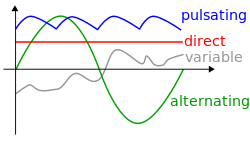Direct Current (DC) Power: definition and applications
Direct Current (DC) Power refers to the unidirectional flow of electrons and is the form of power that is most commonly produced by sources such as solar cells and batteries.
What is power?
Power can be defined as the rate of energy consumed in a unit time. The unit of measurement of power is Watt, after the famous eighteenth century scientist, James Watt who invented the steam engine. In mechanical systems, power is known as mechanical power and is a combination of forces and movement. In electrical systems, electrical power is the rate of flow of electrical energy past a given point in a closed circuit. For our applications we will only consider the electrical power.
Alternating and direct current
Electrical power can be classified as AC Power or DC Power depending upon the direction of the flow of energy. Here AC stands for Alternating Current and DC stands for Direct Current. Power which is a result of current flowing in alternating direction is termed as AC Power and one which is a result of current flowing in only one direction is called DC Power.
Direct current waveform
In DC (Direct current) circuits, the flow of electrical charge (or in other words, electrons) is unidirectional and unlike AC Current, it does not periodically reverses its direction. The typical waveform of alternating current is a pure sine wave as shown in the figure below.
 Norned DC cable between Norway and The Netherlands Source: Wikipedia
Norned DC cable between Norway and The Netherlands Source: Wikipedia
What are common DC applications?
This form of power is most commonly produced by sources such as solar cells, batteries, and thermocouples. DC power is widely used in low voltage applications such as charging batteries, automotive applications, aircraft applications and other low voltage, low current applications. All solar panels nowadays produce DC power. Common applications with DC power in the PV industry are portable solar systems and other off-grid appliances. Not using a solar inverter to convert DC to AC will keep the costs down for such systems.
Advantages and Disadvantages DC current
Nowadays for electric power distribution alternating current is mostly used, as it has significant advantages over direct current in transmission and transforming. One of the biggest advantages of DC power is its ability to be used in special applications. Whenever AC power transmission is not practically feasible or possible over long distances, DC power is used. One such application are sub-sea high voltage DC transmission lines. Here, the electricity is produced in AC form, converted to DC at a switching/ terminal station, transmitted by a subsea network of cables, re-converted to AC by another terminal station and finally delivered to customers.
 Norned DC cable between Norway and The Netherlands Source: Wikipedia
Norned DC cable between Norway and The Netherlands Source: Wikipedia
Sub-Sea DC Transmission Lines
Many such lines are functional to date. Some notable examples are:
- Baltic Cable Link
- Between: Sweden and Germany
- Length: 250 km
- NorNed Cable Link
- Between: Norway and Netherlands
- Length: 580 km
- Basslink
- Between: Australian mainland and Tasmania
- Length: 290 km
A big disadvantage of these High Voltage Transmissions is the higher cost of building terminal stations and switching yards. The parts used need quite a lot of maintenance, which is expensive, and have limited overloading capacity as well.
Looking to ensure the highest quality and reliability in your solar power systems?
Contact Sinovoltaics, to learn how we can help you improve your solar project performance and ensure long-term reliability.

Samuel N.
on 20 Apr 2023R. N. Karmaker
on 07 Sep 2021pabitra sarkar
on 20 Mar 2017shahid shafi
on 04 Jun 2017Paramjit
on 30 Jan 2018Brendan
on 11 Apr 2018Saleem Merchant
on 15 May 2018Abdullah Saeed
on 16 Mar 2022BinaSenapati
on 29 Jul 2021Laxmikant Vishnu Desai
on 01 Feb 2019